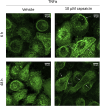Capsaicin attenuates the effect of inflammatory cytokines in a HaCaT cell model for basal keratinocytes
- PMID: 39469627
- PMCID: PMC11513304
- DOI: 10.3389/fphar.2024.1474898
Capsaicin attenuates the effect of inflammatory cytokines in a HaCaT cell model for basal keratinocytes
Abstract
Introduction: The resolution of the skin's inflammatory response is only possible if its barrier function is restored. TRPV1 channel activation plays an important role during inflammation but the effect of this activation on the skin barrier under inflammatory conditions has not been clarified. We hypothesize that it could potentially aid the keratinocyte barrier by reducing inflammatory cytokine release and promoting tight junction development.
Methods: To explore the role of TRPV1 activation in inflammation, we designed and optimized an in vitro model of keratinocytes with basal epidermal layer characteristics using HaCaT cells and TNFα to induce inflammation.
Results: TNFα increased the gene expression of tight junction protein claudin 1 (CLDN1) by at least 2.60 ± 0.16-fold, in a concentration-dependent manner, over a 48 h period. The administration of a capsaicin pre-treatment reduced the CLDN1 expression to 1.51 ± 0.16-fold during the first 6 h after TNFα induction, whereas IL-8 cytokine release was reduced 0.64 ± 0.17-fold. After 48 h, CLDN1 protein levels increased by a factor of 6.57 ± 1.39 compared to cells only treated with TNFα.
Discussion: These results suggest that activation of TRPV1 by capsaicin can potentiate the increase in CLDN1 expression and CLDN1 protein synthesis induced by TNFα in cultured keratinocytes, while reducing the release of IL-8.
Keywords: TRPV1; capsaicin; inflammation; permeability; skin.
Copyright © 2024 Cervantes Recalde, Schmidt, Girardi, Massironi, Rechl, Hans, Stuhlmann, Somoza and Lieder.
Conflict of interest statement
Authors JH and DS were employed by Symrise AG. Authors CG and MM were employed by Symrise Srl. The remaining authors declare that the research was conducted in the absence of any commercial or financial relationships that could be construed as a potential conflict of interest.
Figures







References
-
- Archer C. B. (2010). “Functions of the skin,” in Rook's textbook of dermatology. Editors Burns S. B. T., Cox N., Griffiths C. (Oxford, UK: Blackwell Publishing Ltd.).
LinkOut - more resources
Full Text Sources

